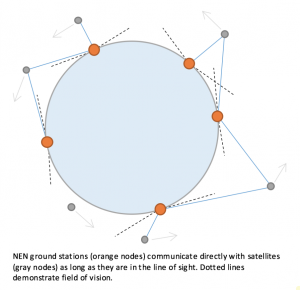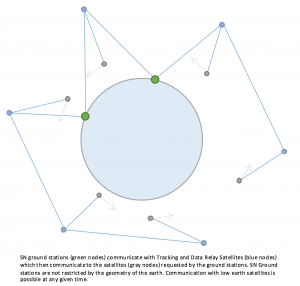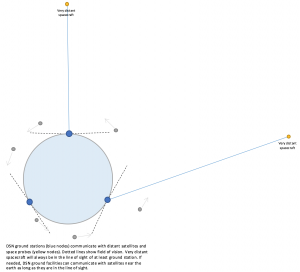Space Communications Networks
The beginning of the Space Race in 1955 between the United States and the Soviet Union initiated efforts to explore and, in some sense, conquer the solar system. Sixty years down the road, the product of such efforts have led to many extraordinary developments. A couple of these developments are artificial satellites (e.g. GPS satellites, the ISS, the Hubble Space Telescope, etc.) and interplanetary space probes (e.g. Voyager I and II, New Horizons, Juno, etc.). With a few exceptions such as the ISS, satellites and space probes are for the most part unmanned and have the capacity to operate semi-autonomously. In spite of their semi-independence, it is still essential for them to maintain communication with Earth. In addition to receiving commands and data from Earth, it is also crucial that they be able to relay back the valuable data they collect. To allow for such communication many communications networks have been established. A few of these networks are the Near Earth Network (NEN), the Space Network (SN), and the Deep Space Network (DSN).
The Near Earth Network (NEN) consists of 14 ground stations which communicate mostly with satellites in low Earth orbits (between 73 km and 3,000 km). In the NEN, ground stations communicate directly to satellites orbiting relatively near the Earth. Satellites in low Earth orbits typically have orbital periods between 85 and 180 minutes, which means a NEN ground station has a limited window during which it can communicate with any particular satellite. During this time window, NEN ground facilities can send commands, track satellites, and receive data collected by the satellites. [1]
Similar to the NEN, the Space Network (SN) is comprised of ground stations, only two though. The key difference between the NEN and the SN is that the SN has additional satellites called Tracking and Data Relay Satellites (TDRS), which effectively extend the scope of the communications network and allow ground facilities to have uninterrupted communication with near Earth satellites. Ground facilities in Guam and White Sand, New Mexico communicate directly with TDRS (in geosynchronous orbits, 35,900 km in altitude) which relay their communications to the appropriate satellites. Through the TDRS constellation, two ground stations are able to track, communicate with, and receive data from satellites any time of the day. [3] [4]
The Deep Space Network (DSN) consists of three ground stations which are responsible for communication with interplanetary space probes and satellites that are in unusual or distant orbits. The three ground stations are located in Goldstone, California; Madrid, Spain; and Canberra, Australia. These ground stations are positioned such that they are roughly 120 degrees apart. Such positioning guarantees distant spacecraft’s ability to communicate with at least one of the three facilities at any given time. Compared to the NEN and the SN, the DSN ground stations have antennas that are far more powerful; as such, the DSN has a far greater communications range than the NEN or the SN. If needed, DSN ground stations can also communicate with satellites in low Earth orbits, however they are typically not utilized in such a manner. Like the NEN, the DSN’s communication with satellites in low orbit is limited by the geometry of the earth in that communication can only be made when a satellite is in the line of sight. [4] [5]
The superposition of just these three networks form a very complicated network that is very dynamic in nature (far more complicated than the diagrams). The relative motion of satellites and space probes through space with respect to ground stations on a rotating planet requires constant change in network structure. Even the SN, which utilizes geosynchronous satellites, needs to constantly reroute communication through the TDRS constellation due to the fact that low earth satellites move relative to the TDRS. The existence and success of such vast and complex communications networks in space is product of innovative and ground breaking engineering.
Sources:
[1] https://www.nasa.gov/directorates/heo/scan/services/networks/txt_nen.html
[2] https://www.nasa.gov/directorates/heo/scan/services/networks/txt_sn.html
[3] https://en.wikipedia.org/wiki/Space_Network
[4] https://www.nasa.gov/directorates/heo/scan/services/networks/txt_dsn.html
[5] http://www.spacetoday.org/SolSys/DeepSpaceNetwork/DeepSpaceNetwork.html



